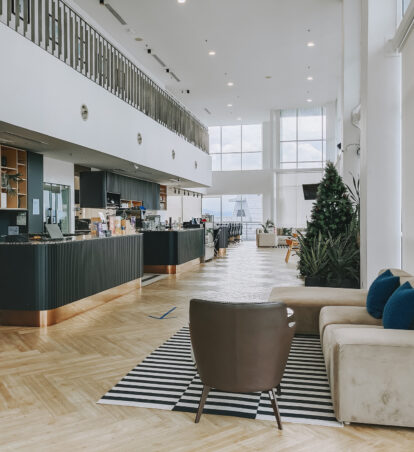Why Your Hotel Is Probably Running Too Many Facebook Ads
One of the most overlooked factors that can make or break your hotel’s Facebook marketing campaigns is the number of ads you run at any given time. While on the surface, it may seem like it’s beneficial to always run more ads, offers, and campaigns than your competitors, a spray-and-pray approach will almost always bring worse results than an effective, controlled hotel ad campaign strategy.
What we’re talking about today has a lot to do with the conversation around ad frequency we posted earlier this year. We’d recommend giving that blog post a read first, but if you don’t have time, here’s a short synopsis:
In order for your hotel’s ad messaging to stick with your target audience, your audience has to see the same message between 2 and 10 times. Running too many hotel ad campaigns to a large audience ends up diluting your messaging, wasting ad dollars, and confusing your customers. It’s important to keep this frequency number in mind when planning your campaigns.
Why shouldn’t our hotel run as many offers/ads as possible?
On the surface, running more hotel offers and ads seems to make sense. On Facebook, we’re serving ads to diverse audiences, from retired people who can easily accommodate a weekday vacation to parents of young children on a long weekend to young professionals looking for a romantic date. Doesn’t it make sense to run offers for all of these groups and more?
This thinking often leads to diluted messaging, confused customers, and fewer conversions as a result. Read on to find out why.
What does a good hotel retargeting campaign strategy look like?
In a hotel retargeting campaign, we’re delivering ads to people who have previously shown interest in staying at your hotel or have recently visited your website. These are customers who probably already know who you are but need a push to be reminded why they should actually book a stay. When considering how many ads and offers to run in your hotel’s retargeting campaigns, we have a few guidelines we recommend:
Run six or fewer ads at a time
Running more than 6 ads at a time makes it hard for the Facebook algorithm to learn enough about your ads to deliver them effectively. Don’t believe us? Take it from them. We recommend having a daily budget of at least $5 per ad, if possible. If your daily budget is $15/day, it is probably wiser to run only 3-4 ads.
Run 3 or fewer offers of hotel messaging types
Now that you’re running six or fewer ads, we can talk about offers. We recommend not running more than 3 offers at any given time, giving room for around 2 ads per offer. For example, you might run 2 ads for a 20% savings offer, 2 ads for an extra night offer, and 2 evergreen ads that aren’t tied to offers at all.
This allows Facebook to deliver the same type of messaging to the same user in multiple ways instead of always having to deliver the same ad to a user that might resonate with a 20% savings offer, for example.
Allow your hotel’s Facebook campaigns to optimize before rotating offers
Once you’ve chosen an offer to run, we recommend running the offer for at least 2 weeks, but preferably longer. It can take days for Facebook to optimize a new ad type or offer, so rotating offers weekly only hinders your hotel’s Facebook campaign performance. Be wary of ad fatigue, though; refresh images and copy at least seasonally.
What does this look like?
Consider the following two hotel Facebook ad accounts (with identifying information removed) from September 2024. In the first screenshot, there are 9 individual hotel offers and one hotel press accolade, each with one ad. Note that the ad frequency for 8 of 10 ads is below 2, meaning on average, the target audience is exposed to each offer less than 2 times. This frequency isn’t high enough to drive a substantial number of bookings.
In the second screenshot, the hotel only runs one offer and a handful of evergreen ads. The two hotel offer ads see a frequency of 3.00 and 2.57. There’s some overlap here, so the number of times the average user is exposed to this offer each month across both ads is 3.62 times. Delivering this offer at a high frequency is driving more bookings for the hotel, specifically on the offer this hotel is prioritizing. In addition to our one hotel offer ad, 3 supplemental evergreen ads help to round out our hotel Facebook campaign, providing less sales-focused copy and reminding customers about the experience they’ll have on the property.
This strategy provides clarity for your hotel’s audience with a specific offer or set of offers, without having so many choices they get overwhelmed.
What does a good hotel prospecting campaign strategy look like?
A good hotel prospecting campaign strategy follows similar rules to an optimal retargeting campaign strategy. The only modification for prospecting is instead of delivering different hotel offers, we recommend experimenting with different messaging points while introducing your hotel to new, unaware audiences. These are the guidelines we recommend:
Run six or fewer ads at a time
Just like with retargeting, we recommend running no more than 6 ads at a time. Again, if your hotel’s budget is less than $30/day, sticking to a rule of $5 per day, per ad is a good starting point when deciding how many ads to run.
Run 3 or fewer hotel messaging aypes
Prospecting is a great place to experiment with new ways to introduce your hotel to prospective guests. We see the most success with four main categories of prospecting ads:
- Evergreen ads
- These ads mirror the imagery and language on your hotel’s website, how you’d describe the experience of staying at your hotel to a new guest.
- Review ads
- Pulling reviews from Google & other websites gives prospective guests confidence they might enjoy their stay and click through to your hotel’s website to find out more.
- Press ads
- Maybe Forbes or Travel & Leisure raved about a stay at your hotel. Quotes from reputable press outlets often provide guests with confidence about your hotel and drive interest, similar to review ads.
- Offer ads
- Although we see the most success with offer ads in retargeting campaigns, sometimes they’re worth experimenting with, combined with softer, more prospecting-focused language.
What does this look like?
Consider the following screenshot (with identifying information removed) from a hotel experimenting with brand pillar ads, review ads, and evergreen ads. Monthly, this hotel rotates between different brand pillars & reviews, turning off ads that are less successful and testing new concepts to avoid ad fatigue. Although ad spend is concentrated between a few ads, all ads were served at least 2,500 times during the month, allowing Facebook to collect adequate data on what ads are driving the most qualified traffic to the website.
(TLDR) Too long; didn’t read
In short, managing your hotel’s ad volume is one of the most important things you can do to improve your Facebook performance. Here are a couple of tips to keep in mind:
- Run 6 or fewer ads in any campaign to allow Facebook to best optimize your hotel’s ads
- Run at least 2 ads for any offer or messaging type so your message can be delivered in multiple ways
- Rotate ads often (but not too often!) to avoid ad fatigue
You deserve a partner in creating your hotel’s Facebook campaign strategies. Reach out to the experts at GCommerce Solutions to learn more about running highly effective campaigns that help drive more guests to your hotel.


